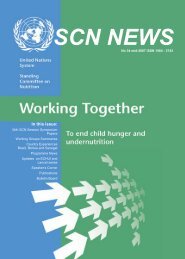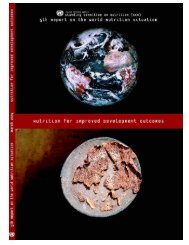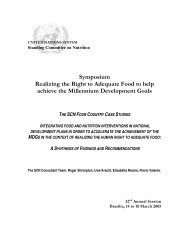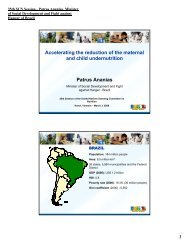Universal Salt Iodization (USI) - FTP Directory Listing
Universal Salt Iodization (USI) - FTP Directory Listing
Universal Salt Iodization (USI) - FTP Directory Listing
- No tags were found...
Create successful ePaper yourself
Turn your PDF publications into a flip-book with our unique Google optimized e-Paper software.
54FEATURESwww.unsystem.org/scnAchieving and sustaining <strong>USI</strong>:Operational considerations and challenges of involving small(er) salt processorsExperiences of the UN World Food Programme and the Micronutrient InitiativeTina van den Briel (WFP, Rome), Mohamed Mansour (WFP, Rome), Luc Laviolette (Micronutrient Initiative, New Delhi),Rizwan Yusufali (Micronutrient Initiative, Johannesburg)Abstract: Enormous progress has been made in the elimination of iodine deficiency with the adoption of universal saltiodization. With 70% of households consuming iodized salt globally, more than 80 million newborns are annuallyprotected from losses in mental capacity due to iodine deficiency. However, 70% is not enough. Every yearapproximately 38 million children are still born unprotected from iodine deficiency. 70% of these children live in just 25countries. Most of these countries are also characterized by large numbers of very vulnerable, food insecure populationgroups, the most needy, ‘hard-to-reach’ people who usually have very little access to fortified foods; including iodizedsalt. The UN World Food Programme (WFP) teamed up with the Micronutrient Initiative (MI) to further build andstrengthen the infrastructure required for iodized salt production in a number of countries. This paper focuses on someof the issues and challenges faced in the effort to expand and strengthen the supply-side of iodized salt production byworking with small and medium-scale salt processors. *Key words: Cottage scale, iodization, salt, small scale, medium scale, processors, self-help groupIntroductionEnormous progress has been made in the last decade since the international community, in coordination withnational governments, set the goal for the elimination of iodine deficiency by 2000, and adopted universal saltiodization as the most effective strategy to achieve this goal. Between 1992 and 2000, the percentage ofhouseholds consuming iodized salt increased from 20% to 70%, resulting in the annual protection of morethan 80 million newborns in the world from losses in mental capacity due to iodine deficiency. However, 70%is not enough. Every year approximately 38 million children are still born unprotected from iodine deficiency;70% of these children live in just 25 countries (UNICEF 2006). There is also evidence of backsliding amongcountries that were successful in controlling iodine deficiency in the past.Among those 25 countries, UNICEF with its international partners identified sixteen “make or break” countrieswith the intention to ensure extended support beyond 2005. The selection criteria were: high number ofunprotected newborns, low level of salt iodization, large salt export activities, as well as a need for specialadvocacy and professional support to renew strategies of the national IDD elimination programme. Thesecountries were: Afghanistan, Angola, Bangladesh, China, Egypt, Ethiopia, Ghana, India, Indonesia, Niger,Pakistan, Philippines, Russian Federation, Senegal, Sudan and Ukraine.Most of these countries are also characterized by large numbers of very vulnerable, food insecure populationgroups; the most needy, ‘hard-to-reach’ people who usually have very little access to fortified foods, includingiodized salt. The UN World Food Programme WFP has ongoing programmes in these and many othercountries and distributes iodized salt, as per its nutrition policies, wherever people are fully dependent onfood assistance and thus are entitled to receive a general ration of cereals, pulses, fortified blended foods,fortified vegetable oil and salt. World wide WFP procures an average of 18,000 metric tons (MT) of iodizedsalt per year (average for period 2000 – 2006), supplying an estimated 10 million of the most vulnerablepeople per year with iodized salt. This salt is bought from 48 countries all over the world. In a few cases inthe past WFP assisted producers in setting up the required machinery to iodize salt.However, a grant from the Canadian International Development Agency enabled WFP to team up with theMicronutrient Initiative (MI) in 2005 to further build and strengthen the infrastructure required for iodized saltproduction in a number of countries. MI already had extensive experience with setting up and providingtechnical support to salt iodization programmes, and was therefore a logical partner in this initiative. Selectedfor this specific initiative were some of the countries classified as ‘make or break’: Ghana, India, Pakistan,Senegal and Sudan. At the country level, partnerships were established with the respective governments, the* This paper refers to interactions with salt processors rather than salt producers because iodization occurs at the time of salt processing.In some cases processing is done by the producers themselves, but in others it is the purview of separate agents.SCN NEWS # 35 back to contents







